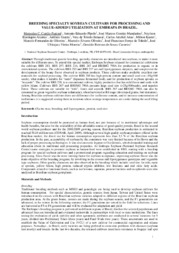Breeding specialty soybean cultivars for processing and value-added utilization at Embrapa in Brazil.
Breeding specialty soybean cultivars for processing and value-added utilization at Embrapa in Brazil.
Author(s): CARRÃO-PANIZZI, M. C.; PIPOLO, A. E.; MANDARINO, J. M. G.; ARANTES, N. E.; GARCIA, A.; BENASSI, V. de T.; ARIAS, C. A. A.; KASTER, M.; OLIVEIRA, M. F. de; OLIVEIRA, M. A. de; TOLEDO, J. F. F. de; MOREIRA, J. U. V.; CARNEIRO, G. E. de S.
Summary: Through traditional genetic breeding, specialty characters are introduced into soybean, to make it more suitable for differents uses. To attend this special market, Embrapa Soybean released for commercial cultivation the cultivars BRS 213, BRS 257, BRS 216, BRS 267 and BRSMG 790A for production in organic or in conventional systems. The cultivars BRS 213 and BRS 257 are null lipoxygenases enzymes, and can prevent the development of the beany flavor observed in soybean products. These cultivars make available excellent raw materials for soyfood processing. The cultivar BRS 216 has high protein content and small seed size (10g/100 seeds), what makes it suitable for ?natto? (Japanese fermented food), and for production of soybean sprouts, as ?moyashi?. The cultivar BRS 258, is a conventional cultivar, highly productive that has mild flavor and seeds with yellow hilum. Cultivars BRS 267 and BRSMG 790A presents large seed size (>25g/100seeds), and superior flavor. These cultivars are suitable for ?tofu?, flours and soymilk. BRS 267 and BRSMG 790A can also be consumed as green vegetable soybean (edamame), when harvested at R6 stage (developed grains, but immature). Among Brazilian soybean cultivars there are differences for isoflavone content, and to increase concentration of isoflavones it is suggested sowing them in locations where average temperatures are cooler during the seed filling period.
Publication year: 2009
Types of publication: Paper in annals and proceedings
Unit: Embrapa Soybean
Keywords: Glycine Max, Melhoramento, Null lipoxygenase, Protein, Proteína, Seed size, Soja, breeding, lipoxygenase
Observation
Some of Embrapa's publications are published as ePub files. To read them, use or download one of the following free software options to your computer or mobile device. Android: Google Play Books; IOS: iBooks; Windows and Linux: Calibre.
Access other publications
Access the Agricultural Research Database (BDPA) to consult Embrapa's full library collection and records.
Visit Embrapa Bookstore to purchase books and other publications sold by Embrapa.

